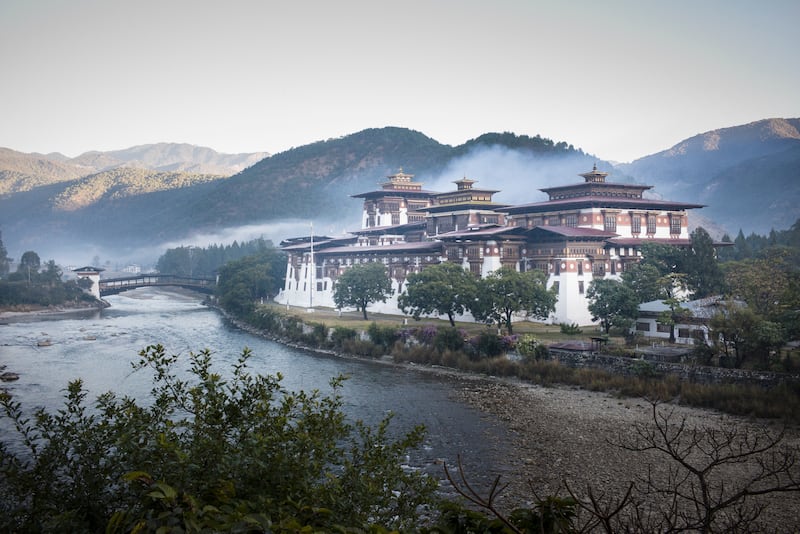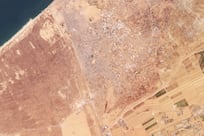There are few countries as mysterious as Bhutan. But for all its mystery, the tiny landlocked nation tops many a traveller’s bucket list. Thanks to its dramatic Himalayan mountain landscapes, striking dzong fortresses and crisp clean air, it’s become a go-to destination for those looking to get off the beaten track.
The fact that it’s home to a selection of some of the world’s most exclusive hotels, including Six Senses, Como and andBeyond properties, certainly helps. Arguably, the most luxurious of all the premium offerings in the country is Amankora, which is where I happened to find myself for a week in January.
A five-star travelling experience, journeying around the country with Aman shows off the breadth of Bhutanese experiences on offer, without any of the logistical quandaries associated with backpacking. The hotel is spread across five distinct lodges, each located in different districts, or Dzongkha, around Bhutan. Aman maps out journeys around the country, factoring in visitors’ requirements and time frames. My six-day visit took me to Amankora lodges in Paro, Thimphu and Punakha in the west of the country, missing the lodges in Gangtey and Bumthang, located in the centre and east.
I arrived in Bhutan with very few preconceptions. Although, a 25-minute YouTube crash course saw me land with a few key details under my hat – the country’s signature dish is a chilli and cheese stew, there are no traffic lights in Bhutan whatsoever and, at 3,280 metres above sea level, it is the country with the highest average elevation on the planet – I had everything else to learn upon arrival.
The flight into Bhutan sets the tone for the entire stay. I flew from Dubai via Kathmandu, and the hour-long Drukair flight was easily one of the most scenic of my life. After flying out of the Nepalese capital, we were soaring above the clouds, with the Himalayan mountains emerging below us. About halfway through the flight, the captain announced that passengers could see Mount Everest to their left. I felt incredibly lucky to be sitting in seat 9A with a clear window view.

As quickly as you ascend, you descend, curling into a valley in the Bhutanese capital and landing in an opulently decorated, but modestly sized, Paro International Airport.
Our first port of call was the Amankora Thimphu lodge in the Bhutanese capital, Thimphu. About an hour’s drive from the airport, it’s a popular first stop on an Aman journey around Bhutan. As close as you’ll get to a city hotel in the Amankora collection, it is nestled in the hills to the north of the city, surrounded by forest and royal residences.
Built in the style of a traditional dzong fortress, Amankora Thimphu is spread across several buildings, built around courtyards with 16 king-size rooms, six of which were occupied when my group of four visited.
Everything about the hotel is built for cosy comfort. Traditional wood-burning stoves in the rooms, tableside fireplaces in the restaurant and fire pits on the terrace ensure warmth on the frostiest of evenings. Hours can be lost sitting on the banquette window-seats, reading and staring out into the forest. Guests can also book warming slots in the spa’s steam room, and staff are on hand to serve warm apple and cinnamon tea at a moment’s notice.

There is a convivial feel to the open-plan dining room, with a lounge to sit in and drink the aforementioned tea, read or play card games. This theme plays out in each of the lodges, as rooms to socialise and relax in make up the heart of the hotel. In Amankora Punakha it’s a Scandinavian-style dining room with communal tables, and in Amankora Paro there are two rooms, one with comfortable sofa areas and a second with long banquet dining tables.
A day in Thimphu is best used hiking, eating and exploring cultural sites and temples. After a hearty warming breakfast of apple porridge, my first full day in Bhutan began at the Buddha Dordenma statue. A striking religious monument that opened in 2015, the gilded Buddha sits atop a monastery, where we were welcomed with a traditional white khata scarf and received a blessing from the head monk.
On a continued spiritual trajectory, in the afternoon, we hiked to Druk Wangditse Lhakhang. Built in 1715, it is among the oldest temples in Thimphu. A low-impact hike to ease our way into the higher altitude walks, it took us about 50 minutes from start to finish, not including our temple visit. From the hillside flat path, the group enjoyed views of the city, with a guide pointing out the official residence of Jigme Khesar Namgyel Wangchuck and Jetsun Pema, or Druk Gyaltsuen, the King and Queen of Bhutan, government buildings and other significant monuments in the capital city.
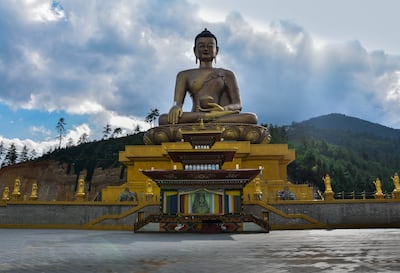
The path is lined with prayer flags, a motif that is repeated throughout the country. Either all white, in tribute to the dead, or strings of five different colours that represent the elements, the prayer flags form part of the forest backdrop, and can be spotted roadside, on hikes and on the approach to temples.
The food in Thimphu served as a perfect introduction to Bhutanese cuisine. Amankora serves a daily set menu – a fine-dining take on the country’s signature dishes, or diners can opt for dishes from the international a la carte selection – the yak carpaccio and smoked trout were personal highlights.
At the hotel, trying the Bhutanese set menu at least once is essential. Dishes include momos, a very similar take to the Nepalese classic; gyen hogay, a cucumber salad; yaksha lhaphu paa, a braised yak dish; nya fin tshem, a locally sourced trout curry; and ema datshi, the famed Bhutanese national dish, a chilli and cheese stew. The dish packs a punch, with green chillies slow cooked in garlic and onions, with local cheese. At Amankora, all of the food is included in the room rate, with selected drinks.
Away from the hotel, we dined at Babesa, a 100-year-old restaurant in a 600-year-old farm house that serves classic Bhutanese fare. The meal began with butter tea and soup, with another take on ema datshi chilli and cheese, as well as beef and chicken stews. The key theme of Bhutanese cuisine is spice – chillies feature in almost every warming stewed dish.
It was then time to travel from Thimphu to Phunaka. On the day we left the capital, we woke up to flurries of snow, which made for an exciting and beautiful drive over the mountain pass, climbing up to 3,500 metres. About a three-and-a half-hour journey into a new valley, we were greeted by an entirely new subtropical climate in Phunaka. The pine and fir trees of Thimphu were swapped for cacti and agave, with banana, avocado, mango and orange trees growing in orchards. If you visit Bhutan in the summer, you’ll be greeted by vibrant purple jacaranda trees in the valley.
For those in search of outdoor pursuits, Phunaka is a holidaymaker’s dream. The entrance to the lodge is accessible via a suspension bridge crossing the blue Mo Chhu River. On the other side a buggy greets visitors, ferrying them to the hotel, which is housed inside a farmhouse leased from the royal family.
A reflection of the warmer climes, the lodge has a swimming pool and a large outdoor terrace, as well as a spa and private dining rooms.
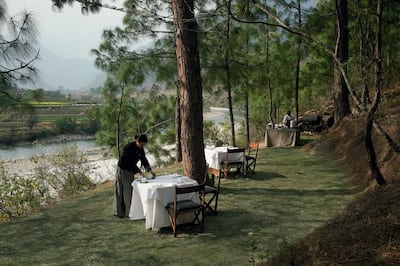
During our stay, we take on an hour’s hike up to Khamsum Yulley Namgyal Chorten, built in 2004 by Tshering Yangdon, mother of the king. It began as an easy 45-minute walk through fields of cows and past streams, finishing with a challenging final stretch up hill. After the hike, we tried our hands at archery, the national sport of Bhutan, and took a rafting trip down the river, where our enthusiastic guide pointed out wildlife indigenous to the area.
To wrap up our stay in Phunaka, we visited the valley’s dzong, the second oldest fort in the country.
Built in the 17th century, the ornate riverside citadel is the administrative centre of the district and a must-visit, with striking murals depicting Bhutanese and Buddhist history painted throughout.
The final leg of my three-lodge journey took me to Amankora Paro. Another three-and-a-half-hour drive back towards the airport town. Other guests I met on the trip were planning to continue into Amankora Bumthang and take a domestic flight back to Paro. Our journey remained on terra firma, but a highlight was driving past a family of Nepalese grey langurs in trees on the side of the road.
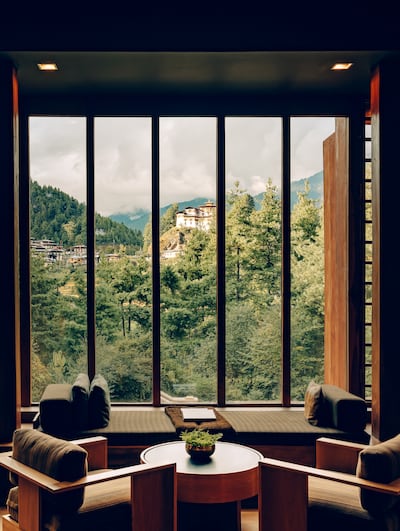
Amankora Paro has the feel of a hidden lodge, accessible through a fir forest, with the hotel tucked away in a clearing. It has a very similar aesthetic to the Thimphu and Phunaka lodges, with stone buildings, wooden design features and almost identical rooms, which gives the multiple hotel experience a thread of continuity. After dinner, we had an early night to prepare for the hike up to Tiger’s Nest.
Easily the most famous monument in Bhutan, Paro Taktsang, more commonly known as Tiger’s Nest, is a cliff-side monastery, accessible via a 4.5km hike up to the site. Far from a walk in the park, the hike is suitable for people of varying fitness levels if they go at their own pace.
That said, the final stretch of steep stairs is a push for even the fittest of hikers. The reward, however, is abundant. Stunning views of the monastery kept me motivated as I walked, and looking down on the valley from above was a breathtaking experience.
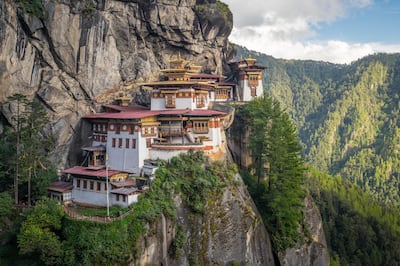
On the way down, we were rewarded with a Bhutanese lunch at an Aman-owned cabin and then whisked back to the hotel’s spa for a Japanese onsen bath. The open bath, heated with volcanic rock, had secluded views over the lodge’s private patch of forest.
Poetically, though unintentionally so, I ended my trip as it began – reading a book and soaking up lush, green forest views, urging time to slow down so that I could enjoy every final moment in Bhutan.
